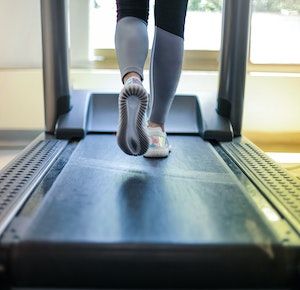A new study found that older adults living in communities given 80-minute perturbation-based balance training (PBT) interventions had a statistically nonsignificant reduction in fall rates, although a statistically significant fall rate decrease was observed in a laboratory setting.1
Falls are known to be the leading cause of injury for older adults, including those in communities who tend to fall due to trips and slips.2 As a result of falls, costs and rehabilitation can be a tremendous difficulty for many elderly adults.
Summary
- Falls are a leading cause of injury for older adults, with prevention through physical exercise viewed as one of the most effective approaches.
- A randomized clinical trial aimed to evaluate the effects of a four-session treadmill PBT intervention compared to regular treadmill walking on daily-life fall rates among community-dwelling older adults.
- Perturbation training did not have a substantial effect on daily-life fall rates, but it may help to reduce laboratory fall rates for older adults.
- The study included 140 community-dwelling older adults with a mean age of 72 years, and those in the intervention arm were given four 20-minute PBT sessions in total.
- The investigators suggested developing more task-specific treadmill perturbations to facilitate clinically feasible and more effective PBT.
Yet falls can be prevented, with physical exercise being viewed as one of the most efficient approaches for prevention. To examine PBT as a means of prevention, this study was authored by Jens Eg Nørgaard, MSc, from the Department of Geriatric Medicine at Aalborg University Hospital in Denmark.
“The recently published world guidelines for fall prevention highlight PBT as a future research priority,” Nørgaard and colleagues wrote. “Therefore, this randomized clinical trial (RCT) aimed to evaluate the effects of a 4-session treadmill PBT intervention compared with regular treadmill walking on daily-life fall rates among community-dwelling older adults.”
Background and Findings
The investigators used an assessor-blinded, parallel-group, randomized trial with a 1:1 ratio, and they conducted their research between March of 2021 and December of 2022 in Aalborg University’s laboratory.
The team recruited adults aged 65 years or older using radio and television ads as well as snowball sampling, and participants had to be able to walk without a walking aid and live in the community to be included.
Participants were excluded from the study if they had certain self-reported conditions, including progressive neurological disease, orthopedic surgery within the past 12 months, and osteoporosis or osteoporosis-related fractures. Those with unstable medical conditions that prevented safe participation or severe cognitive impairment were also excluded.
The investigators randomly assigned the recruited participants to either be in the intervention group (given PBT training) or the control group (treadmill walking). All data analyses were then performed following the intention-to-treat principle.
In the end, the researchers included 140 community-dwelling older adults with a mean age of 72 years, of whom 56% were females and 41% had reported a fall in the past 12 months.
Those in the intervention arm were given four 20-minute PBT sessions in total, involving 40 slip, trip, or mixed slip and trip perturbations. Meanwhile, those in the control arm underwent four 20-minute sessions of treadmill walking at their preferred speed.
The beginning 3 training sessions done with the participants were completed within the first week, while the fourth session was conducted following 6 months. The research team made the primary outcome daily-life fall rates observed over the 12-month time frame following the third training session, as reported on fall calendars.
The researchers determined secondary outcomes to be the proportion of participants experiencing at least one fall, recurrent falls, time to the first fall, fall-related fractures, fall-related injuries, fall-related health care contacts, and daily-life slip and trip falls.
Overall, the team noted that perturbation training did not have a substantial effect on daily-life fall rates (incidence rate ratio [IRR]: 0.78; 95% CI, 0.48 - 1.27) or other fall-related metrics. They did, however find that there was a significant reduction in laboratory fall rates at the post-training assessment (IRR, 0.20; 95% CI, 0.10 - 0.41), at the 6-month follow-up (IRR, 0.47; 95% CI, 0.26 - 0.86), and at the 12-month follow-up (IRR, 0.37; 95% CI, 0.19 - 0.72).
The investigators added that their findings suggest that perturbation training may not be effective in reducing daily-life fall rates, but it may help to reduce laboratory fall rates for older adults.
“Although treadmills may be less task specific, they are less space consuming, cheaper, and easier to operate than overground setups, making them more clinically feasible,” they wrote. “Thus, developing more task-specific treadmill perturbations (eg, obstacle-induced trips) may facilitate clinically feasible and more effective PBT.”
References
- Nørgaard JE, Andersen S, Ryg J, et al. Effect of Treadmill Perturbation-Based Balance Training on Fall Rates in Community-Dwelling Older Adults: A Randomized Clinical Trial. JAMA Netw Open. 2023;6(4):e238422. doi:10.1001/jamanetworkopen.2023.8422.
- Burns E, Kakara R. Deaths from falls among persons aged ≥65 Years—United States, 2007-2016. MMWR Morb Mortal Wkly Rep. 2018;67(18):509-514. doi:10.15585/mmwr.mm6718a1.






